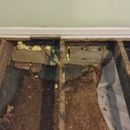Crawl space in the country with rough block walls
I just tore out the bedroom subfloor in our 1930s country house. We were having mold issues and the crawl space was less than 10″ high so I could not accesss it.
Previous owners randomly shoved fiberglass insulation in there, which was a nesting ground for possums and squirrels.
I got all that cleaned up, and amazingly the rough sawn tar covered joists (2x10s 24 OC) are in great shape without any mold. The insulation was a mess of wet and mold, so my ideal is to somehow seal the crawl space and use no floor insulation between the joists.
The sill joists sit on dry stacked concrete block which are not square to each other, and are broken etc in places. The level is achieved with stones etc on top of the short wall. I think the only way to seal this is to use spray foam.
My questions are: Do I try to affix some sort of insulation to these rough walls? Would it be better to simply fill the block voids with great stuff and put a good vapor barrier down on the dirt floor? Do I leave the voids in the vent blocks open or seal them (they are simply concrete blocks turned sideways)?
Any other advice on this? Part of my though is just to warm the floor with a heating mat on top and leave the crawlspace uninsulated as it originally was built aside from sealing with foam and vapor barrier.
The home is in Asheville NC. We get virtually daily rain in the summer so it can be quite damp. Winter lows well below freezing, but average is not too bad. The moisture is well managed on the perimeter of the house.
GBA Detail Library
A collection of one thousand construction details organized by climate and house part










Replies
Grover,
The correct way to fix this house is to jack it up. Remove the existing foundation. Excavate under the house if necessary. Install a new crawl space foundation with poured concrete walls. Ideally, the new foundation will be considerably higher than the existing foundation.
I know, that's expensive. So you'll probably patch everything up and cover it with a new plywood subfloor so you don't have to look at it. (That's probably what I would do, even though I know it's the wrong way to proceed.)
If you're going for halfway measures, the correct type of insulation to apply on the interior side of your crawl space walls is closed-cell spray polyurethane foam. Good luck.
For more information, see this article: Building an Unvented Crawl Space.
Thanks Martin, does great stuff count as closed cell polyurethane foam? The room is only 12X16, so getting a contractor out seems excesssive :-)
One concern I had about rigid or really any foam including the spray foam is if there is ground contact with the foam, do ants / termites / etc like to crawl up the stuff into to wood?
And I do believe that I won't be jacking the house up. Did that once, and would have been better off tearing the whole house down!
Grover,
You probably want a two-component spray foam kit, not 40 or 50 cans of Great Stuff. Here is a link to one source:
http://www.betterenergystore.com/productpage.asp?p=4
Cool. I appreciate it.
There will be no access to the space again after the subfloor goes down. Is there a problem with termites eating into this stuff, and if so, should I simply forgo it altogether since there is no access?
Grover,
I'm not a termite expert, so you should seek local advice. But to the best of my knowledge, the whole point of leaving a termite inspection strip is so that you can see the critters' mud tunnels during your annual inspection. The whole issue becomes moot if no one ever goes in the crawl space to inspect, so I can't imagine that the spray foam will do any harm.
You should check with your local code enforcement official to see whether the spray foam needs to be covered with a so-called thermal barrier to reduce the fire risk.
If you need a termite inspection strip, it will have to be on the exterior of your building.
I've seen some funky-looking concrete block walls in my day, but your foundation may get the prize.
.